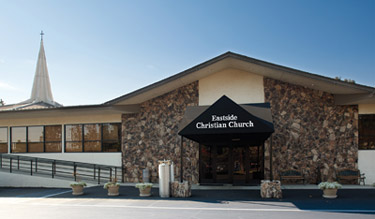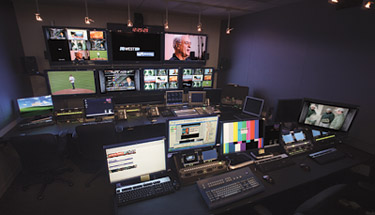Staying Faithful to Design

Eastside Christian Church
FULLERTON, CALIF.
Experience shows that faith-based broadcasting facilities obey this truism: churches are designed to be churches—fitting (or retrofitting) a broadcast infrastructure into an existing church means working around the church structure itself. For San Diego-based integrator TV Magic, the high-definition upgrade of the Fullerton, Calif., Eastside Christian Church provided a clear example of working around a church.
“The control room, for lack of a better word, was an attic,” said Steve Milley, vice president of sales at TV Magic. “It was an attic that had limited space, height, limited size, and difficulty in accessing it, with a 10-foot high spiral staircase to haul the equipment up there.”
In addition to just accessing Eastside Christian’s attic control room, TV Magic faced the problem of fitting in a new 24-input Grass Valley HD Kayak switcher and audio console to join an existing Final Cut Pro editing system. The added rack of equipment then meant they had to modify the HVAC system to cool the confined space.
FUTURE GROWTH
Milley gave the 800-seat church high marks for prioritizing and working with a long-term plan. “Like a lot of facilities, they had a limited budget, but they were looking down the line for when more money would become available,” he said. For example, the HD Kayak switcher was a large expenditure item, which limited the church to minimal cameras, in their case four Sony EX3s. Three of the cameras are regularly manned during a service, the fourth operated by remote pan and tilt.
“The concept behind that was for future growth, because with the Kayak they could later add a lot of ‘goes-ins’ and ‘goes-outs,’” said Milley. “And they save the cost of adding an outboard router, because the 1.5 M/E, 10-output Kayak acts as a router. So they spent a lot of money on just the switcher, yet kept the cost down on the other components, like the cameras.
“These guys are pretty smart, because over the years they knew where they wanted to go, so they bought bits and pieces, had a growth path.” He pointed to the Sanyo projectors the church had previously purchased. “All we had to do was add HD-SDI cards to them to make them HD-capable, and then map the screens to be 16:9.”
THEATER, NOT TV
When Advanced Broadcast Solutions did a recent HD upgrade to the Kirkland, Wash. City Church main sanctuary broadcasting infrastructure, ABS’s president Mark Seigel pointed to another challenge of working with churches. “Most churches were designed in the theatrical style, not designed to have television in them.” This means camera positions are where you can find them, not designed into the church architecture. “You had to open up soffits and walls and run the cabling, bring power to certain locations.”
And again, there was the matter of finding a space for a control room in a church. “As is typical, they don’t have enough space, they have a closet,” said Seigel. “They don’t really have a proper environment to do that type of production.”

TV Magic converted Eastside Church’s attic into a production control room. ABS designed what Seigel calls a “pseudo HD” system for City Church. “They couldn’t afford to replace all these SD cameras and go to HD glass, so what they’ve done is take their 16:9 SD cameras and go through a Broadcast Pix Production switcher. In the switcher the camera video is up-converted to HD.”
Seigel said there are some advantages beyond just cost in sticking with the SD cameras. “Once you’ve gone to HD, the first thing that you do is you have to increase the light in the facility roughly by 15 percent because you need more light for high def. You also go to the detail circuits and turn everything down, because it shows every flaw, every pock, every wrinkle.”
The upconverted HD video is sent to the IMAG HD projection systems in the Kirkland church.
And since 2004, City Church has done multi-site services, where a portion of the service from the Kirkland main sanctuary is satellite-delivered to five City Church campuses in and around the Seattle area, where it’s integrated live into their local services. The pastor has monitors in front of him with video from each of the satellite congregations so that he can interact with them during the services.
City Church also produces a youth TV program “City Kids” each week that is available over the Internet, and audio and video of recent services are available via streaming.
Seigel said one key to City Church’s being able to pull off this sophisticated media model is that they have some staff with mainstream broad-casting experience. “Everybody thinks it so easy, and it’s not. Many churches don’t have a good knowledge base in their media staff.”
And broadcast infrastructure designers for faith based facilities will have to live with the fact that a church is, first and foremost, a church.
Get the TV Tech Newsletter
The professional video industry's #1 source for news, trends and product and tech information. Sign up below.
